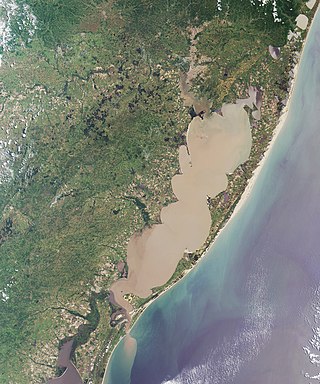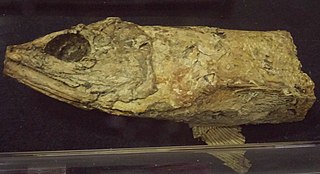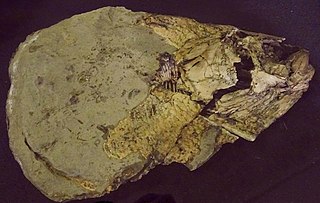Related Research Articles
The Campos Basin is one of 12 coastal sedimentary basins of Brazil. It spans both onshore and offshore parts of the South Atlantic with the onshore part located near Rio de Janeiro. The basin originated in Neocomian stage of the Cretaceous period 145–130 million years ago during the breakup of Gondwana. It has a total area of about 115,000 square kilometres (44,000 sq mi), with the onshore portion small at only 500 square kilometres (190 sq mi).

Berycopsis is an extinct genus of marine ray-finned fish from the Late Cretaceous period. Fossils are known from England, Germany, and Lebanon. A potential specimen is known from the Czech Republic.

Pachyrhizodus is an extinct genus of ray-finned fish that lived during the Cretaceous to Paleocene in what is now Europe, North America, South America, and Oceania. Many species are known, primarily from the Cretaceous of England and the midwestern United States.

Mawsonia is an extinct genus of prehistoric coelacanth fish. It is amongst the largest of all coelacanths, with one quadrate specimen possibly belonging to an individual measuring 5.3 metres in length. It lived in freshwater and brackish environments from the late Jurassic to the mid-Cretaceous of South America, eastern North America, and Africa. Mawsonia was first described by British paleontologist Arthur Smith Woodward in 1907.
The Griman Creek Formation is a geological formation in northern New South Wales and southern Queensland, Australia whose strata date back to the Albian-Cenomanian stages of the mid-Cretaceous. It is most notable being a major source of opal, found near the town of Lightning Ridge, New South Wales. Alongside the opal opalised fossils are also found, including those of dinosaurs and primitive monotremes.
The Adamantina Formation is a geological formation in the Bauru Basin of western São Paulo state, in southeastern Brazil.

Araripichthys is an extinct genus of marine ray-finned fish that lived from the Aptian to Coniacian stages of the Cretaceous period. The genus is named after the Araripe Basin, where it was found in the Crato and Santana Formations. Other fossils of the genus have been found at Goulmima in Morocco, the Tlayua Formation of Mexico and the Apón Formation of Venezuela.
Ctenocephalichthys is an extinct genus of prehistoric ray-finned fish that lived during the Santonian.
Adriacentrus is an extinct genus of prehistoric marine bony fish that lived in the Turonian in what is now Croatia. It contains a single species, A. crnolataci. Formerly considered a beryciform fish, it is now known to be more closely related to the squirrelfish (Holocentridae).

The Straight Cliffs Formation is a stratigraphic unit in the Kaiparowits Plateau of south central Utah. It is Late Cretaceous in age and contains fluvial, paralic, and marginal marine (shoreline) siliciclastic strata. It is well exposed around the margin of the Kaiparowits Plateau in the Grand Staircase – Escalante National Monument in south central Utah. The formation is named after the Straight Cliffs, a long band of cliffs creating the topographic feature Fiftymile Mountain.

The Carlile Shale is a Turonian age Upper/Late Cretaceous series shale geologic formation in the central-western United States, including in the Great Plains region of Colorado, Kansas, Nebraska, New Mexico, North Dakota, South Dakota, and Wyoming.
The Cenomanian-Turonian boundary event, also known as the Cenomanian-Turonian extinction, Cenomanian-Turonian Oceanic Anoxic Event, and referred to also as the Bonarelli Event or Level, was an anoxic extinction event in the Cretaceous period. The Cenomanian-Turonian oceanic anoxic event is considered to be the most recent truly global oceanic anoxic event in Earth's geologic history. There was a large carbon cycle disturbance during this time period, signified by a large positive carbon isotope excursion. However, apart from the carbon cycle disturbance, there were also large disturbances in the ocean's nitrogen, oxygen, phosphorus, sulphur, and iron cycles.

Caipirasuchus is an extinct genus of sphagesaurid notosuchians known from the Late Cretaceous of northern São Paulo State, southeastern Brazil. The type species, C. paulistanus, was named in 2011. A second species, C. montealtensis, was referred to Caipirasuchus in 2013 after having been named in 2008 as a species of Sphagesaurus. A third species, C. stenognathus, was described in 2014. A fourth species, C. mineirus, was described in 2018. A fifth species, C. attenboroughi, was named in 2021 in honour of David Attenborough.
This list of fossil fish species is a list of taxa of fish that have been described during the year 2012. The list only includes taxa at the level of genus or species.
Melvius is a genus of vidalamiin amiid fish from the Late Cretaceous. The type species, Melvius thomasi, was described by Bryant in 1987 from Hell Creek Formation. A second species Melvius chauliodous, was named and described by Hall and Wolburg in 1989 from Kirtland Formation, and it is now considered to be one of the index taxa of the Kirtlandian land-vertebrate age. Both species of Melvius were very large at its size. A vertebral remain of M. thomasi would belongs to fish with standard length of 161 cm (5.28 ft), and there are some specimens exceeds height of that vertebra. Total length of this species would be at least 193–205 cm (6.33–6.73 ft). However, M. thomasi would be a “dwarf” compared to M. chauliodous, a specimen of M. chauliodous with abdominal centra which is 6.57 cm (2.59 in) wide would indicate standard length over 2 m (6.6 ft), and there is even larger abdominal centra which is 7.3 cm (2.9 in) wide.

Suskityrannus is a genus of small tyrannosauroid theropod from the Late Cretaceous in southern Laramidia. It contains a single species, Suskityrannus hazelae, and the type specimen was found in the Turonian-age Moreno Hill Formation of the Zuni Basin in western New Mexico.

The Pelotas Basin is a mostly offshore sedimentary basin of approximately 346,000 square kilometres (134,000 sq mi) in the South Atlantic, administratively part of the southern states Santa Catarina and Rio Grande do Sul of Brazil and the departments Cerro Largo, Rocha and Treinta y Tres of Uruguay.

Goulmimichthys is an extinct genus of ray-finned fishes in the family Pachyrhizodontidae. The genus, first described by Cavin in 1995, is known from various Turonian age formations. The type species G. arambourgi from the Akrabou Formation in the El Rachidia Province of Morocco, and other fossils described are G. gasparini of the La Frontera Formation, Colombia, and G. roberti from the Agua Nueva Formation of Mexico.

Juana Lopez refers to both the uppermost member of the Carlile Shale formation and to the environment that caused it to form. The Juana Lopez Member is calcareous sandstone dated to the Turonian age of the Upper Cretaceous and is exposed in the southern and western Colorado, northern and central New Mexico, and northeastern Utah. The unit has been described as "the most enigmatic" member of the Carlile Shale.

Bachea is an extinct genus of ray-finned fish that lived during the Late Cretaceous in what is now central Colombia, South America. The type species is Bachea huilensis, described in 1997 by María Páramo from the Turonian of Huila, Colombia.